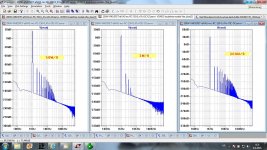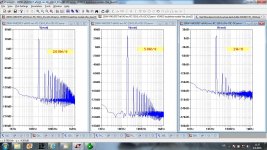A hearty shiraz or cabernet fills the bill - in the old days you could stand a spoon upright in some of our stuff, 🙂 ...What is "solid red stuff"... something that you smoke ?
OS
Many of those are outstanding, and I tend to forget about them until I play one "by accident".
Lately I'm listening to Sheffield d-to-d's in remembrance of Doug Sax. Too many people dying lately, but at least some are provoking tributes.
I'm still nowhere close to understanding why vinyl can sound so good when we all know it measures so questionably. Toole is thoroughly disenchanted with the medium and gave me the last few feet of his LPs which he'd been saving out of nostalgia. I was tickled. Lot of d-to-d, test records, old spoken word and folk, etc.
The D to D LP were a major improvement of the era. It falls into my own favorite theory of less is more. Bypassing recording electronics made a big improvement.
I am clearly in F.Toole's camp about the LP, though. It is a case where some newest formats measure better and also sound better.
THx-RNMarsh
They both may have similar levels of feedback but the first one has 7x more H3 than the second one, even though H2 is dominant.
The first amp has much less open-loop linearity, regardless of the quality of the harmonics. You could say it has a harmonic generator in it. You could achieve the same effect by using an SE buffer in front of the second amp. How do you know the first amp doesn't have all the harmonics of the second amp, just hidden by the harmonics being generated?
So it's a lopsided comparison. There do exist situations where SE and symmetrical circuits produce highly identical harmonic results, simply because they are not the dominant sources of distortion.
Also, try choosing the Hanning or Blackman window in the FFT dialog to get the noise floor lower (smooth noise floor = spectral leakage from rectangular FFT window).
I know all of that, I designed the circuits.
The question was witch one will sound better? Does harmonic structure of first, sound better and more natural ,even with higher distortion?
I suppose burgundy is "stiff enough" to be the stuff. Burgundy and HAM ,A hearty shiraz or cabernet fills the bill - in the old days you could stand a spoon upright in some of our stuff, 🙂 ...
death at 52 , goes hand in hand.
Borgo 'know's it all - design'ed it " I should ask him for the "Key". I'd rather
ask Cordell or Curl.
I can't tell you "witch one sounds better" , but with my modular deal ...
I''l have 'em all beat soon. (a premeditated absolute goal).
If I DO "find the key" (I'm insane - it might happen) I will share
with ALL.
OS
I know all of that, I designed the circuits.
The question was witch one will sound better? Does harmonic structure of first, sound better and more natural ,even with higher distortion?
In my experience, the first one tends to mask unpleasantness, but also takes some music with it. Each situation is different so a different level of masking may be preferred for different applications. Ideally, there would be no need for masking, and that's what I aim for. My hobby however, is not to build masking devices into my power amps. I would rather have separate effect circuits which are optional.
Yes. IME effect circuits are never needed, the detail in the recording itself of musically related sounds, ie., those that would have been heard if you had been standing next to the microphones used, are sufficient always to compensate for failings in the recording and source preparation process. If you can 'hear' your playback system working, as a separate entity to what's on the recording, then more work should and can be done to lift the standard of SQ - you should be able to have a series of "correct" systems, made up of entirely different components, in separate listening environments, and take a single recording from one to the next in line - and subjectively always hear the "same thing" ...Ideally, there would be no need for masking, and that's what I aim for. My hobby however, is not to build masking devices into my power amps. I would rather have separate effect circuits which are optional.
What MOSFET models are you using , those HF artifacts in class AB are
excessive. OS
I'm using Bob C's models for all the devices in this one.
This is my 200W CFA VMOSFET amp and it's working and sounds very nicely. Here are FFT, but only simulated.
Attachments
Last edited:
DVV ,
Why do think I'm listening to a 250W H/K 680 right now (that can do 1/2Kw peaks).
I have the original 680 , gave it to my daughter. It beat the pioneer's , sansui's
all the other mid-fi that has passed my bench by. (I kept the H/K - it stood out).
PS - here is a HK !! (below)1/2 KW of 680 OPS's shaking the house
powered by a 400V/uS CFA - Blasphemy !
OS
WEll now, that is something not out of H/K's door. The original 680 has two pairs of output devices 2SC3907/2SA1516, and the rest is your putting it on steroids. I never did anything like that because I had no need, my speakers are extremely well behaved and relatively efficient at 91 dB/2.83V/1m (JBL Ti600 floorstanfers) sitting in a smallish room, playing music for its actual owner, my wife, who has a very sensitive hearing, man, she can hear the paint dry and the grass grow.
I console myself with a P2400 power amp for the bass and Citation 24 for the mid and treble. 170W and 100W. No idea how much can these put out, but I'm willing to bet they would fry most speakers if I let them rip. Biamping is fun! I have yet to refresh the 2400, I'm currently looking for capacitors I can still stick in instead of the 12,000 uF ones already inside. With a little luck, I might be able to install 22,000 uF, there appears to be sufficient free space for them. Now, that would be something!
The second kind?
The second kind are those who prefer beer to wine. 😀
OS, I forgot to mention this.
The 680 is the only amp I have ever come across in my life which decidely did not like being given more bias current. Adding some to the factory settings did not have the effect of improving the sound - it made the sound a little sweeter, but at the cost of losing some resolution. In the end, I returned it to its factory setting, realizing that it was indeed the best overall setting. Sometimes, there is no second guessing.
The 680 is the only amp I have ever come across in my life which decidely did not like being given more bias current. Adding some to the factory settings did not have the effect of improving the sound - it made the sound a little sweeter, but at the cost of losing some resolution. In the end, I returned it to its factory setting, realizing that it was indeed the best overall setting. Sometimes, there is no second guessing.
200W CFA VMOSFET amp FFT at 20kHz.
Attachments
Last edited:
A recurring topic: what do you guys think of this - is he making sense? I have trouble wrapping my brain around it.
Website of Wayne Stegall - Noise Shaping Music: DSD-like coding inside PCM digital audio content increases its resolution
Jan
Website of Wayne Stegall - Noise Shaping Music: DSD-like coding inside PCM digital audio content increases its resolution
Jan
Dick
You can also represent that as 00100 or just 4.
ES
Thanks...you've forever tainted the phrase "I've done this all for you".😀
jn
"What's correct isn't original, what's original isn't correct."A recurring topic: what do you guys think of this - is he making sense? I have trouble wrapping my brain around it.
There are two kinds of people:
those who can exprapolate conclusions from incomplete data.
There are 10 kinds of people in this world, those who can count in binary, and those who can't.
your choice. Find your most sensitive conditions and report that result.
-RNM
Ok, well I am not an audiophile if that’s what you mean.
What I have found by listening is generally what the work on perceptual masking would suggest.
The 2nd order has to be quite large (like large 10 to 30%) to be detectable with music but less with natural sounds which tend not to be harmonic in structure.
I should qualify detectable, by that I mean as a detrimental sound.
At high frequencies, to me it seems like we are much less sensitive than lower down and if one looks at an equal loudness curve and ones hearing sensitivity up high, one can see why. How loud would the 5th harmonic of 15KHz have to be, to be audible over the masking of the fundamental, given that hearing curve?
At low frequencies, also because of the hearing sensitivity curve, at 20Hz, at the threshold of audibility, a 3rd harmonic in the 5 to 10% range has the same apparent loudness as the fundamental at 70-80dB SPL.
With a 20Hz pure tone, passing through my old BGW pre-amp, the 17th harmonic was the largest seen on the 3562a. I forget the THD (normally the first 10 harmonics) but it was very low% yet passing the 20Hz tone, in headphones, you could clearly hear a “whirr” at 3400Hz that accompanied it.
So, maybe I should just say it really depends haha.
Best,
Tom Danley
I think one could say in addition to masking that if you took the equal loudness curves and inverted them, one has the hearing sensitivity curve for a given actual loudness vs frequency.
Given that shape, it shows how ones ears weighs the actual loudness of the fundamental and harmonics for a given frequency tone.
- Status
- Not open for further replies.
- Home
- Member Areas
- The Lounge
- John Curl's Blowtorch preamplifier part II

